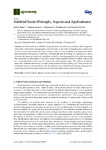Artificial Seeds (Principle, Aspects and Applications)
| dc.contributor.author | Rihan, H | |
| dc.contributor.author | Kareem, F | |
| dc.contributor.author | El-Mahrouk, M | |
| dc.contributor.author | Fuller, M | |
| dc.date.accessioned | 2018-01-09T20:35:00Z | |
| dc.date.available | 2018-01-09T20:35:00Z | |
| dc.date.issued | 2017-12 | |
| dc.identifier.issn | 2073-4395 | |
| dc.identifier.issn | 2073-4395 | |
| dc.identifier.other | ARTN 71 | |
| dc.identifier.uri | http://hdl.handle.net/10026.1/10525 | |
| dc.description.abstract |
Artificial seeds are artificially encapsulated somatic embryos (usually) or other vegetative parts such as shoot buds, cell aggregates, auxiliary buds, or any other micropropagules which can be sown as a seed and converted into a plant under in vitro or in vivo conditions. An improved artificial seed production technique is considered a valuable alternate technology of propagation in many commercially important crops and a significant method for mass propagation of elite plant genotypes. The production of plant clones multiplied by tissue culture and distributed as artificial seeds could be a useful alternative to the costly F1 hybrids for different plant crops. The delivery of artificial seeds also facilitates issues such as undertaking several ways for scaling up in vitro cultures and acclimatization to ex vitro conditions. The development of an artificial seed technique also provides a great approach for the improvement of various plant species such as trees and crops. | |
| dc.format.extent | 71-71 | |
| dc.language | en | |
| dc.language.iso | en | |
| dc.publisher | MDPI | |
| dc.subject | synseed | |
| dc.subject | sodium alginate | |
| dc.subject | encapsulation | |
| dc.subject | micropropagules and micropropagation | |
| dc.title | Artificial Seeds (Principle, Aspects and Applications) | |
| dc.type | journal-article | |
| dc.type | Review | |
| plymouth.author-url | https://www.webofscience.com/api/gateway?GWVersion=2&SrcApp=PARTNER_APP&SrcAuth=LinksAMR&KeyUT=WOS:000419168500010&DestLinkType=FullRecord&DestApp=ALL_WOS&UsrCustomerID=11bb513d99f797142bcfeffcc58ea008 | |
| plymouth.issue | 4 | |
| plymouth.volume | 7 | |
| plymouth.publication-status | Published | |
| plymouth.journal | Agronomy | |
| dc.identifier.doi | 10.3390/agronomy7040071 | |
| plymouth.organisational-group | /Plymouth | |
| plymouth.organisational-group | /Plymouth/Faculty of Science and Engineering | |
| plymouth.organisational-group | /Plymouth/Faculty of Science and Engineering/School of Biological and Marine Sciences | |
| plymouth.organisational-group | /Plymouth/REF 2021 Researchers by UoA | |
| plymouth.organisational-group | /Plymouth/REF 2021 Researchers by UoA/UoA06 Agriculture, Veterinary and Food Science | |
| plymouth.organisational-group | /Plymouth/Users by role | |
| plymouth.organisational-group | /Plymouth/Users by role/Academics | |
| dcterms.dateAccepted | 2017-10-27 | |
| dc.identifier.eissn | 2073-4395 | |
| dc.rights.embargoperiod | Not known | |
| rioxxterms.versionofrecord | 10.3390/agronomy7040071 | |
| rioxxterms.licenseref.uri | http://www.rioxx.net/licenses/all-rights-reserved | |
| rioxxterms.licenseref.startdate | 2017-12 | |
| rioxxterms.type | Journal Article/Review |


